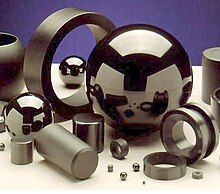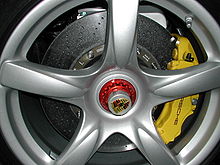Technical ceramics


As technical ceramics are ceramic materials referred to, which have been optimized in their properties for technical applications out. It differs from the decoratively used ceramics or crockery (utility ceramics), tiles or sanitary objects and the like. a. due to the purity and the narrowly tolerated grain size (grain size range) of their raw materials and often through special combustion processes (e.g. hot isostatic pressing , burning in a reducing atmosphere).
Other names for technical ceramics engineering ceramics , advanced ceramics , industrial ceramics and industrial ceramics .
Ceramic materials that have special electrical or piezoelectric properties are also known as functional ceramics .
One can speak of technical ceramics since the first technical applications of porcelain as electrical insulators in the middle of the 19th century.
General
Ceramic materials are inorganic , non- metallic and polycrystalline . As a rule, they are formed at room temperature from a raw material formed from ceramic powder, organic binder and liquid and only acquire their typical material properties in a sintering process at high temperatures.
This is the big difference to many other classes of material, especially metals. While these have their main material characteristics after smelting and before shaping, in the case of ceramic products, material properties, shape and size are inextricably linked with the manufacturing process steps, consisting of processing the powder, shaping and firing. The actual engineering performance therefore lies in the precise design of the production and, above all, in the targeted influencing of the microstructures in the final sintering process.
If the carbon or chromium content plays a role in steel, for example, and in plastics the choice of reactants and their degree of crosslinking, in the case of ceramic materials it is not just a matter of which basic material ( boron nitride , silicon carbide or aluminum oxide ) forms the basic body, but also decides here rather, the type and frequency of imperfections (e.g. pores, micro-cracks, the smallest amount of foreign matter) in the finished component via the specific properties. The application-related variation of the properties of ceramic materials therefore occurs to a far greater extent through the design of the process steps than is the case with metals. Different firing processes and firing atmospheres as well as the grain size and firing temperature can be used to achieve a wide variety of properties of the same mixture of substances. One example is the reaction firing, with which silicon-enriched silicon carbide ( SiC ) is manufactured from silicon and carbon powder under protective gas. Complex, comparatively large structures can be manufactured without the usual shrinkage during sintering . SiSiC has the high hardness, thermal conductivity, chemical resistance and corrosion resistance of silicon carbide, but the silicon embedded in the pores improves the oxidation resistance, so that this ceramic is suitable for use as a heating element or structural part in kilns.
The technical challenge in manufacturing increases with the size and shape of a ceramic component: a uniform, homogeneous structure must be maintained over a large volume, although heat can only be supplied from outside during firing. At present, heating tubes for metal annealing, forging and hardening furnaces are among the world's largest ceramic components in technical ceramics. They reach dimensions of up to 3 meters in length and up to 30 cm in diameter. Approx. 40 manufacturers worldwide are able to produce engineering ceramics products with these dimensions.
Material properties
Technical ceramics can have the following very different material properties:
- Heat resistance up to well over 1000 ° C ( heating elements )
- electrical insulation ( spark plugs , high voltage , electronic circuits ( high frequency and thick film circuits ))
- high dielectric constants ( ceramic capacitors with high volume capacitance)
- Abrasion and wear resistance (sliding surfaces, nozzles for laser and water jet cutting (cutting nozzles ), plain bearings in pumps , pistons and cylinders ), powder coating of metal surfaces
- Great hardness (e.g. in ball bearings , used as a cutting material (cutting ceramic), during machining (cutting ceramic is much harder than steel ))
- Corrosion resistance (salt water, chemical applications (especially in pumps in the chemical industry), coating of metals)
- Medical technology applications (good biocompatibility in combination with strength )
- low thermal expansion
- low density
- high mechanical strength, but combined with low fracture toughness
- Dimensional stability (high specific stiffness or high modulus of elasticity )
- low or high thermal conductivity depending on the type
- Depending on the type, high electrical insulation properties or semiconductor or piezoelectric properties (functional ceramics)
- ferroelectric properties ("epsilane", ceramic multilayer capacitors (MLC), electrets )
As with conventional ceramics, it is manufactured by baking crystalline powders, known as sintering . In order to ensure constant material quality and reliability, the production of high-purity powders with a defined, fine grain size (sometimes less than 1 µm), their preparation with sintering aids and drying and sintering are of great importance. In the event of fire (sintering), the grain size is retained or increases due to grain growth. While aiming for small grain sizes for mechanical applications and multilayer capacitors, z. For example , a compromise can be found for burner tubes for gas discharge lamps ( sodium vapor lamps , metal halide lamps ) in order to achieve mechanical strength (small grains) and high optical transparency (large grains, few scattering centers).
There is often a so-called intergranular phase between the crystalline grains, which is essential for the electrical and mechanical properties. Although it makes the sintering process easier, it is often avoided because it is responsible for mechanical creep processes and falling insulation values, especially in high-temperature applications. In order to obtain high-density ceramics without an intergranular phase or sintering aids, sintering takes place partially under pressure (hot isostatic pressing, HIP).
The ceramic-compatible construction of the components can also help to reduce the risk of failure due to brittle fracture: Sharp notches and inner corners must be avoided and changes in wall thickness should not be gradual, but as continuous as possible. When subjected to bending or tensile stress, notches and corners are easily the starting point for a crack, the spread of which then goes through the entire component and destroys it, even with low forces.
With the development of ceramic composite materials , different types of materials are now available in the field of technical ceramics, which are characterized by significantly higher fracture toughness and the associated reliability as well as extreme thermal shock resistance.
Material groups
-
Oxide ceramics
- Single material systems: aluminum oxide , magnesium oxide , zirconium oxide , titanium dioxide (capacitor material)
- Multi-component systems such as aluminum titanate (mixed form of aluminum and titanium oxide ), mullite (mixed form of aluminum and silicon oxide ), lead zirconate titanate ( piezoceramics ), or dispersion ceramics such as aluminum oxide reinforced with zirconium oxide (ZTA - Zirconia Toughened Aluminum Oxide) - Al 2 O 3 / ZrO 2 .
-
Non-oxide ceramics
- Carbides , for example silicon carbide , boron carbide
- Nitrides , such as silicon nitride , aluminum nitride , boron nitride , titanium nitride
- Boride
- Silicides
Piezo ceramics are used as ceramic resonators in electronic circuits, in piezo injection valves for diesel engines , in actuators (valves, mirrors, atomic force microscope ) and in micro and high-frequency loudspeakers .
Applications
Ceramic materials are used today in areas where metals were previously used. Just a few decades ago, applications that are taken for granted today were not considered feasible.
Ceramic materials are used in medical technology to replace bones and teeth. The high mechanical strength and wear resistance as well as the high corrosion resistance and good compatibility with living tissue are important here ( bioinert ).
So-called hot applications are an important area of application. These include furnace construction, burner systems or heating elements. Some ceramic materials withstand operating temperatures of up to 2500 ° C without distortion or fatigue. Due to the ever higher temperatures (higher efficiency !) Sought in internal combustion engines , development costs and demands on components such as bearings, turbine blades of the turbocharger and engine parts are increasing.
The most common applications in terms of quantities are technical ceramics as electronic components in the form of ceramic capacitors . In addition, due to the high dielectric strength, the ceramic power capacitors are indispensable in transmission systems .
The best-known applications, however, are ceramic components as insulators or insulating materials ( spark plugs , overhead line insulators). Temperatures of 600 ° C, such as occur, for example, in spark plugs or ignition devices for gas burners, are also possible. The aluminum oxide ceramic used in spark plugs has a specific resistance of 10 8 Ωcm at 600 ° C.
Most ceramic materials are electrical insulators , but some are superconducting , semiconducting or serve as heating conductors.
Semiconducting ceramics are used for varistors (zinc oxide), hot or cold conductors ( temperature sensors , inrush current limitation , demagnetization , self-resetting fuse elements ( PTC fuse element)).
Ceramic materials also dominate in bearing and sealing technology. Ceramic materials can be used as bearing shells for gas turbines with speeds of several thousand revolutions per minute and temperatures of around 1500 ° C. In pumps, ceramic mechanical seals seal the shaft feedthroughs through the pump housing from the outside world against corrosive and abrasive media. During flue gas desulphurization , ceramic slide bearings in the pumps are exposed to highly concentrated, alkaline milk of lime, which is heavily contaminated with sand. Similar conditions prevail in pump systems for seawater desalination . Pumps with ceramic plain bearings convey the salt water, which is heavily contaminated with sand, for years without suffering from abrasion or corrosion.
A major disadvantage in mechanical applications is the brittle fracture behavior of ceramics (low fracture toughness ). Metallic materials, on the other hand, are ductile and therefore break less often. They forgive lighter construction tolerances by reducing local stress peaks through elastic and plastic deformation. The development of ceramic fiber composite materials has made significant progress in this area and has significantly expanded the range of applications for ceramic materials.
Ceramic powders made from titanium nitride , for example, are used as solid lubricants in assembly pastes such as hot-screw compounds .
literature
- J. Kriegesmann (Ed.): DKG - Technical Ceramic Materials . HvB-Verlag , Ellerau 2005, ISBN 978-3-938595-00-8
- W. Kollenberg (ed.): Technical ceramics - basics, materials, process engineering . Vulkan-Verlag , Essen 2004, ISBN 3-8027-2927-7
- Hartmut Kainer: Handbook for heat exchangers: Ceramic heat exchangers for high-temperature process technology . Vulkan-Verlag , Essen 1991, pp. 205-233
Web links
- [1] Technical information from the Center for Technical Ceramics
- [2] Fraunhofer Center for High Temperature Lightweight Construction HTL: Research and development of Ceramic Matrix Composites (CMC), ceramic fibers and high-performance ceramics